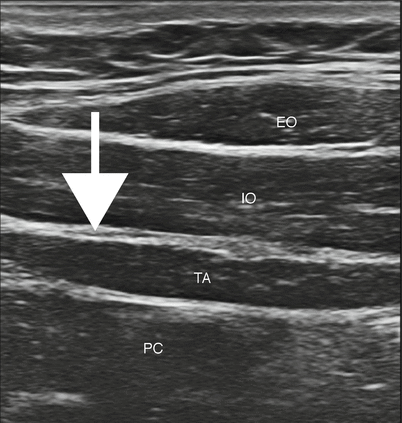Fig. 53.1
Lumbar triangle (triangle of Petit) and the neurovascular plane targeted for landmark approach to TAP block. (1) External oblique, (2) internal oblique, (3) transversus abdominis, (4) latissimus dorsi, (5) serratus posterior inferior muscle, (6) erector spinae, (7) quadratus lumborum (8) psoas major, (9) iliac crest. Transversus abdominis plane is shaded orange (Original illustration by Michael Ee with permission)
Anatomy
The anterolateral abdominal wall muscles (external oblique, internal oblique, and transversus abdominis) are replaced by a well-defined aponeurosis, the linea semilunaris, at the lateral border of the rectus sheath (Fig. 53.2). This is an important sonoanatomical landmark for performing TAP and rectus sheath blocks [8, 9]. The rectus sheath contains the rectus abdominis muscles, the anterior rami of the lower sixth thoracic nerves (T7–T12), the superior and inferior epigastric vessels, and lymph vessels. It is formed by the fusion of the aponeuroses of the three anterolateral abdominal wall muscles. The abdominal wall is innervated by the T6–T11 intercostal and T12 subcostal nerves (Fig. 53.3). The intercostal nerves exit the intervertebral foramina and enter the paravertebral region related to the intercostal muscles posteriorly. Between the midline and the anterior axillary line, segmental nerves T6–T9 emerge from the costal margin to enter the TAP. The T10 segmental nerve is located caudal to the costal margin (rib 10) and T11, T12, and L1 are located in a caudal direction, toward the iliac crest. The TAP contains intercostal, subcostal, and first lumbar (L1) nerves and blood vessels (deep circumflex iliac, inferior epigastric, superior epigastric arteries) (Fig. 53.3). The lateral cutaneous branch of the intercostal nerves divides into anterior and posterior cutaneous branches. The origins of the lateral cutaneous nerves are proximal close to the costal angle. However, the point at which lateral cutaneous nerves pierces muscle layers is more anterior at the angle of rib or midaxillary line [10]. The lateral cutaneous branches are significant because they innervate much of the abdominal wall (T6–T12) and thorax (T1–T5). The anterior cutaneous nerve sends twigs to the external oblique muscle as well as skin to the lateral margin of the rectus abdominis. The posterior branch runs backward supplying the paravertebral region as well as the erector spinae.
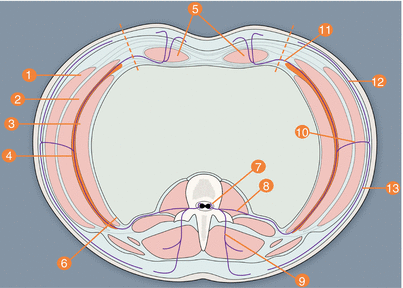
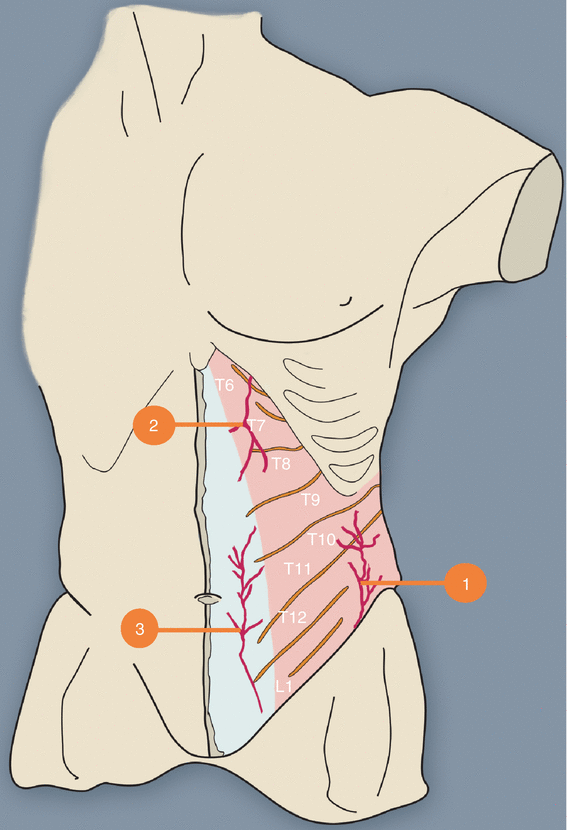

Fig. 53.2
Cross section of abdominal wall. (1) External oblique, (2) internal oblique, (3) transversus abdominis, (4) transversus abdominis plane (shaded orange), (5) rectus abdominis, (6) parietal peritoneum, (7) spinal cord, (8) ventral ramus, (9) dorsal ramus, (10) lateral cutaneous nerve, (11) anterior cutaneous nerve, (12) anterior branch of lateral cutaneous nerve, (13) posterior branch of lateral cutaneous nerve; linea semilunaris (orange-dotted lines) (Original illustration by Michael Ee with permission)

Fig. 53.3
Nerves and vessels within transversus abdominis plane. (1) Deep circumflex iliac artery, (2) superior epigastric artery, (3) inferior epigastric artery (Original illustration by Michael Ee with permission)
The iliohypogastric nerve (IHN) and ilioinguinal nerve (IHN) are branches of L1 and these pass laterally through the psoas muscle, course anterior to the quadratus lumborum and travel caudally toward the iliac crest on the inner surface of the transversus abdominis muscle. The nerves pierce the transversus abdominis muscle to enter the TAP plane at variable locations (Fig. 53.4). They are located in the TAP for a short distance only. Medial to the anterior superior iliac spine, the IIN passes through internal oblique close to the inguinal ligament [11, 12]. It is at this location that landmark techniques usually aim to locate the IIN. The IHN is usually above and medial to it [13]. The IIN and IHN supply the skin and muscles of the pubic and inguinal region and genitalia. In summary, the IHN and IIN are located in the TAP close to the iliac crest and anterior superior iliac spine [14]. Medial and inferior to the anterior superior iliac spine, the nerves are located between the internal and external oblique muscles [15].
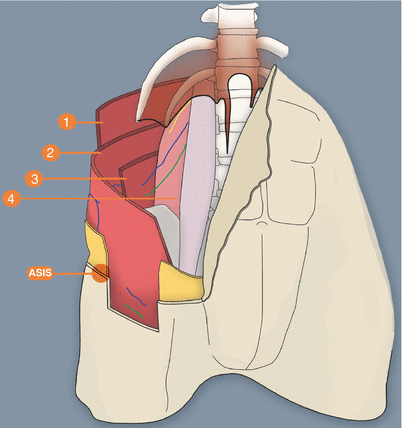

Fig. 53.4
Course of subcostal, iliohypogastric, and ilioinguinal nerves. (1) External oblique, (2) internal oblique, (3) transversus abdominis, (4) quadratus lumborum; anterior superior iliac spine (ASIS); subcostal nerve (yellow); iliohypogastric nerve (blue); ilioinguinal nerve (green); diaphragmatic crura (black outline) (Original illustration by Michael Ee with permission)
The lower five intercostal nerves pierce the lateral margin of the linea semilunaris to enter the rectus sheath posterolaterally. The intercostal (T6–T9), subcostal, and L1 nerves terminate in the rectus abdominis muscle with three patterns: (1) terminate simply within the muscle, (2) supply the muscle and then terminate as a cutaneous branch, or (3) pass through the muscle and terminate as a cutaneous branch [10]. Rozen et al. [16] noted that as the nerves approach the posterior surface of the rectus abdominis, a longitudinal branch of fibers run craniocaudally with the deep inferior epigastric artery. In addition, the cutaneous branches were closely related to the perforating musculocutaneous vessels. Together T7–L1 supply the skin from the xiphoid sternum (T7 nerve root) to the pubic symphysis (L1 nerve root), with T10 nerve supplying the umbilical segment. The IHN nerve supplies the lowermost segment of the rectus abdominis muscle and overlying skin.
The posterior abdominal wall is composed of muscles bound by the thoracolumbar fascia (Fig. 53.5). The thoracolumbar fascia is an extensive tough membranous sheet that envelops the muscles of the posterior abdominal wall, dividing these into anterior, middle, and posterior layers. Key paired muscles of the posterior abdominal wall are psoas major, iliacus, and quadratus lumborum [17].
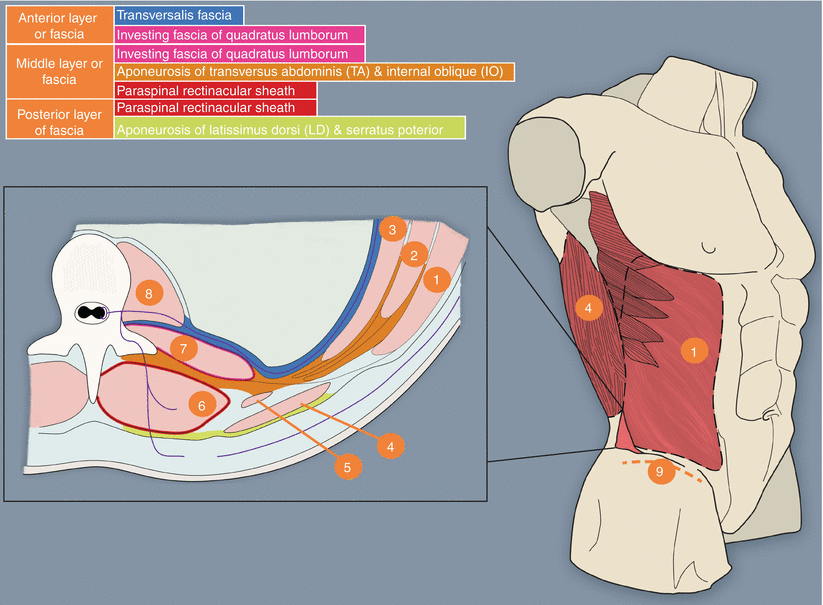

Fig 53.5
Thoracolumbar fascia and relationship to posterior and lateral abdominal wall muscles. (1) External oblique, (2) internal oblique, (3) transversus abdominis, (4) latissimus dorsi, (5) serratus posterior inferior muscle, (6) erector spinae, (7) quadratus lumborum, (8) psoas major, (9) iliac crest (Original illustration by Michael Ee with permission)
Indications
Surgical
TAP blocks have provided surgical anesthesia in high-risk patients for abdominal wall hernia repair, emergency laparotomy [18, 19], and elective Cesarean delivery [20]. The site of block insertion can be modified according to the anticipated site of surgical incision [21]. Despite these case reports, TAP blocks are rarely used for surgical anesthesia.
Therapeutic
Most commonly, TAP blocks are used as one component of multimodal postoperative analgesic technique. They have been effective following colorectal surgery [3], appendicectomy [22], cholecystectomy, prostatectomy, Cesarean section [23], gynecological surgery [24], hernia repair, and renal transplantation [25]. The TAP block is well described following pediatric surgery [26, 27] providing analgesia following ambulatory surgery including hernia repair [28]. A systematic review of studies has demonstrated clinically significant reductions of postoperative opioid requirements and pain [29]. In addition to reduced opioid-related side effects [30], TAP blocks have reduced postoperative opioid consumption in laparoscopic colorectal surgery [31]. A summary of current evidence is provided in Table 53.1. Continuous TAP blockade has been used for treatment of chronic pain [32], for complex traumatic pelvic fractures [33] and for rescue analgesia [34].
Table 53.1
Efficacy of TAP blocks reported in randomized controlled trials
Publication | Surgical procedure | N | Local anesthetic dosage | Comparator | Effect of TAP block on primary outcome |
|---|---|---|---|---|---|
El-Dawlatly (2009) [35] | Laparoscopic cholecystectomy | 42 | 15 ml 0.5 % bupivacaine bilaterally (n = 21) | No TAP (n = 21) | Decrease in PCA morphine use in PACU and ward 1st 24 h |
Niraj (2009) [36] | Open appendicectomy | 52 | 20 ml 0.5 % bupivacaine unilaterally (n = 26) | No TAP (n = 26) | Reduced morphine use and reduced VAS score (at rest and cough) in 1st 24 h. Decreased PONV at 30 min but not at 24 h |
Jankovic (2009*) [37] | Renal transplant recipients | 40 | 20 ml 0.375 % levobupivacaine then 0.15 % bupivacaine 10 ml/h (n = 7) | No TAP (n = 33) | TAP block reduced morphine requirement and duration of PCA use. No difference in pain scores |
Griffiths (2010) [24] | Gynecological cancer surgery | 65 | 20 ml 0.5 % ropivacaine bilaterally (n = 32) | Normal saline placebo (n = 33) | No significant difference in opioid use |
Mukhtar (2010) [38] | Renal transplant recipients | 20 | 20 ml 0.5 % bupivacaine unilaterally (n = 10) | No TAP (n = 10) | Decrease in morphine use. Decrease in pain up to 12 h. Less sedation up to 6 h. Lower PONV scores up to 6 h |
Ra (2010) [39] | Laparoscopic cholecystectomy | 54 | 30 ml 0.25 % compared with 30 ml 0.5 % levobupivacaine bilaterally (n = 18, 18) | Normal saline placebo (n = 18) | In TAP groups: decrease in i.v. opioid use and pain up to 24 h. No difference between 0.25 % and 0.5 % levobupivacaine |
Conaghan (2010) [40] | Laparoscopic colorectal surgery | 74 | 20 ml of 0.25 % levobupivacaine bilaterally (n = 40) | No TAP (n = 34) | Decrease in i.v. opioid use. Decreased length of hospital stay |
Milan (2011) [41] | Liver transplant | 34 | 20 ml 0.5 % levobupivacaine bilaterally (n = 17) | No TAP (n = 17) | Reduced morphine consumption and median pain scores |
Aniskevich (2011)a [42] | Pancreas transplant | 1 | 20 ml 0.5 % ropivacaine bilaterally | n/a | Successful use of TAP block for postoperative rescue analgesia in chronic opioid user |
Bharti (2011) [43] | Colorectal surgery | 40 | 20 ml 0.25 % bupivacaine bilaterally (n = 20) | Normal saline placebo (n = 20) | Decreased morphine use and rest and dynamic pain. Reduced sedation in TAP group (0 to 6 h). Improved patient satisfaction |
Atim (2011) [44] | Hysterectomy | 55 | 20 ml 0.25 % bupivacaine bilaterally (n = 18) | Normal saline placebo (n = 18) and local wound infiltration 0.25 % bupivacaine (n = 19) | Reduced pain compared to both placebo and local infiltration |
Sandeman (2011) [26] | Pediatric Laparoscopic appendicectomy | 87 | 0.5 ml/kg 0.2 % ropivacaine bilaterally (n = 42) | Local infiltration to port sites only (n = 45) | No clinically important benefit |
Niraj (2011) [45] | Open hepatectomy and renal surgery | 62 | Bilateral TAP catheter (n = 29), 1 mg/kg 0.375 % bupivacaine | Epidural (n = 33) | No difference in pain scores and PONV |
Melnikov (2011) [46] | Major gynecological surgery for cancer | 58 | 0.375 ml/kg 0.25 % bupivacaine with 5 mcg/ml adrenaline bilaterally (n = 19) | Bilateral thoracic paravertebral block (n = 19) | No difference in pain scores and PONV |
Kadam (2011) [47] | Major abdominal surgery | 20 | 15 ml 0.5 % ropivacaine with continuous infusion 0.2 % ropivacaine bilaterally (n = 10) | No TAP (n = 10) | Reduced pain scores and fentanyl consumption |
Petersen (2012) [48] | Laparoscopic cholecystectomy | 74 | 20 ml 0.5 % ropivacaine bilaterally (n = 37) | Normal saline placebo (n = 37) | Some reduction in VAS scores for pain on coughing and slightly less opioid requirement |
Tan (2012) [49] | Cesarean section | 40 | 20 ml 0.25 % levobupivacaine bilaterally (n = 20) | No block (n = 20) | Reduction morphine consumption, increased patient satisfaction |
Tolchard (2012) [50] | Laparoscopic cholecystectomy | 43 | 1 mg/kg bupivacaine unilaterally (n = 21) | Local infiltration to port sites only (n = 22) | Reduced VAS scores and fentanyl requirement in PACU |
Walter (2013) [31] | Laparoscopic colorectal surgery | 68 | 20 ml 0.2 % levobupivacaine bilaterally (n = 33) | No TAP (n = 35) | Reduced opioid use 1st 24 h |
Albrecht (2013) [51] | Laparoscopic gastric-bypass surgery | 70 | 30 ml 0.25 % bupivacaine with adrenaline bilaterally (n = 35) | Local infiltration to port sites only (n = 35) | No difference in opioid consumption during 1st 24 h. Rates of PONV equivocal |
Sinha (2013) [52] | Laparoscopic bariatric surgery | 100 | 20 ml 0.375 % ropivacaine bilaterally (n = 50) | No TAP (n = 50) | Reduced opioid requirements and VAS scores |
Sahin (2013) [53] | Pediatric inguinal hernia repair | 57 | 0.25 % levobupivacaine 0.5 ml/kg unilaterally (n = 29) | Wound infiltration (n = 28) | Reduced pain, prolonged effect |
Wu (2013) [54] | Radical gastrectomy | 82 | 20 ml 0.375 % ropivacaine bilaterally (n = 27) | Thoracic epidural (n = 29), GA only (n = 26) | TAP reduced opioid consumption than GA alone; equivocal pain scores. Thoracic epidural less opioid consumption than TAP block; equivocal pain scores |
Parikh (2013) [55] | Donor nephrectomy | 60 | 25 ml 0.375 % bupivacaine unilaterally (n = 30) | Placebo control with saline (n = 30) | Reduced tramadol consumption in the 1st 24 h |
Gasanova (2013) [56] | Total abdominal hysterectomy | 74 | Group 1, 20 ml 0.5 % bupivacaine bilaterally (n = 25) with multimodal analgesia; Group 2, TAP block only (n = 24) | Group 3, multimodal analgesia only, no TAP block (n = 25) | Pain on coughing less variable where TAP block was combined with multimodal analgesia. No difference in pain at rest |
Sivapurapu (2013) [57] | Lower abdominal gynecological surgery | 52 | 0.3 ml/kg 0.25 % bupivacaine bilaterally (n = 26) | Direct wound infiltration (n = 26) | Reduced VAS and increased time to request first rescue analgesia |
Gomez-Rios (2014)b [58] | Major gynecological and obstetric surgery | 6 | Continuous infusion of 0.125 % levobupivacaine 2 ml/h bilaterally for 50 h | n/a | Reduced opioid requirements and improved postoperative mobility |
Niraj (2014) [59] | Laparoscopic cholecystectomy | 61 | Four-quadrant TAP block 2.5 mg/kg 0.375 % levobupivacaine plus continuous infusion 0.25 % levobupivacaine (n = 30) | Epidural (n = 31) | No difference between groups in VAS scores at rest or with coughing |
Aniskevich (2014) [60] | Laparoscopic assisted nephrectomy | 21 | 20 ml 0.5 % ropivacaine, lateral approach bilaterally (n = 10) | Placebo saline control (n = 11) | Reduced opioid requirements and lower pain scores at 24 h |
Mckeen (2014) [61] | Post-Cesarean delivery | 74 | Spinal anesthetic and post-op US-guided TAP, low-dose ropivacaine (n = 35) | Control (n = 39) | No statistically significant difference in pain scores, sedation, or opioid consumption |
Soltani (2014) [25] | Renal transplant recipients | 44 | Post-induction under US guidance 15 ml 0.25 % bupivacaine and adrenaline (n = 22) | Placebo control with saline (n = 22) | Decreased morphine consumption and lower pain scores in 1st 24 h. Reduced intraoperative fentanyl consumption in TAP group |
Calle (2014) [62] | Laparoscopic hysterectomy | 197 | Bilateral with 0.25 % bupivacaine | Placebo control with saline | No difference in opioid requirements at 24, 48, 72 h postoperatively |
Marais (2014) [63] | Open total abdominal hysterectomy | 30 | 20 ml 0.25 % bupivacaine bilaterally (n = 15) | Placebo control with saline (n = 15) | Reduced PCA morphine use |
Chandon (2014) [64] | Post-Cesarean analgesia | 65 | 20 ml 0.375 % levobupivacaine bilaterally (n = 36) | Continuous wound infusion (n = 29) | No difference in rest and dynamic pain scores between groups. Study terminated early due to generalized seizure in 1 patient in TAP group |
Bhatacharjee (2014) [65] | Total abdominal hysterectomy | 90 | 1 ml/kg 0.25 % bupivacaine bilaterally (n = 45) | Placebo control with saline (n = 45) | Lower rest and dynamic VAS scores in immediate postoperative period |
Heil (2014) [66] | Hernia surgery | 20 | 20 ml 0.5 % ropivacaine bolus plus continuous infusion 0.2 % ropivacaine (n = 10) | Placebo control with saline infusion (n = 10) | No significant difference in dynamic pain scores on postoperative day 1 |
De Oliveira Jr (2014) [67] | Laparoscopic gastric banding | 19 | 20 ml 0.5 % ropivacaine bilaterally (n = 10) | Placebo control with saline (n = 9) | Improved quality of postoperative recovery and reduced opioid use |
Contraindications
Infections and skin diseases in the injection area
Surgical dressings obstructing access
Patient refusal
Advantages/Disadvantages
TAP blocks reduce side effects associated with epidural or opioid analgesia failure rate and need for re-siting of block or catheter.
Inadequate analgesic coverage for visceral pain.
Procedure
Preparation
As with all regional anesthesia procedures, requirements include emergency equipment, monitoring, and assistance.
Materials and Disposables
We recommend a 38–50-mm intermediate frequency probe for adult patients.
Sterile ultrasound probe cover and gel for all procedures.
Routine disposables including fenestrated drape and dressings.
21- or 18-gauge short-bevel needles for single-injection or continuous catheter techniques, respectively, 100–150-mm needle required for in-plane technique
20–30 ml of local anesthetic for block (see section on Local Anesthetic Dosage, Volume, and Spread)
Patient Positioning
Supine however consider lateral or lateral tilt for more posterior approach
Ergonomics
We suggest positioning the ultrasound machine on the opposite side of the patient to the proceduralist, so that he/she directly faces the screen. We suggest first scanning by identifying the rectus abdominis muscles, then the linea semilunaris aponeurosis (separating the rectus abdominis from the three anterolateral abdominal wall muscles), and then the anterolateral muscles (Fig. 53.6). Dynamic scanning from medial to lateral or vice versa helps with correct identification of muscle layers (Fig. 53.7). In many patients, the rectus abdominis muscle is displaced further away from the midline than expected. To identify the TAP, it is useful to appreciate: (1) the transversus abdominis muscle may appear hypoechoic, and (2) the transverse abdominis muscle passes under the rectus abdominis close to the xiphisternum. Therefore, scanning in the upper part of the abdomen toward the midline is very helpful in locating the transverse abdominis muscle. Injecting between the rectus abdominis and transverse abdominis muscles close to the xiphisternum may increase the likelihood of anesthetizing T6–8 segmental nerves.
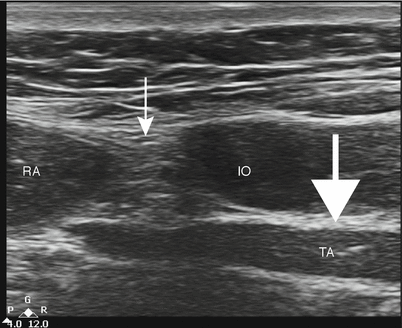

Fig. 53.6
Linea semilunaris under ultrasound. Linea semilunaris (white arrow), rectus abdominis (RA), internal oblique (IO), transversus abdominis (TA), transversus abdominis plane (bold white arrow)

